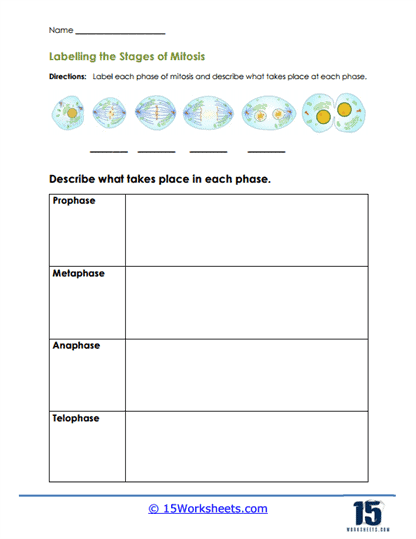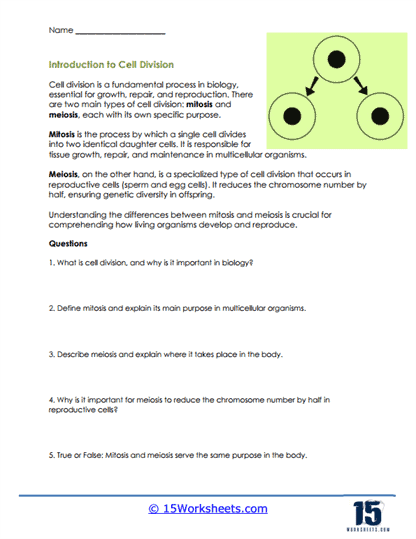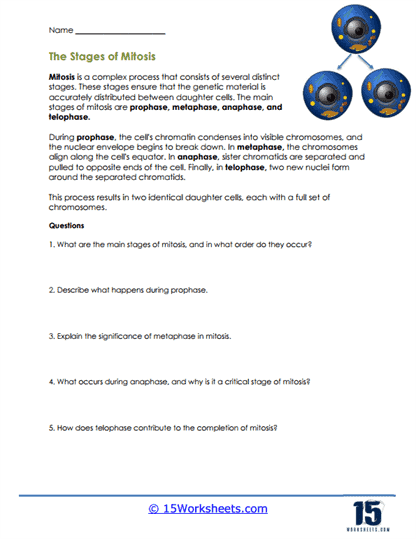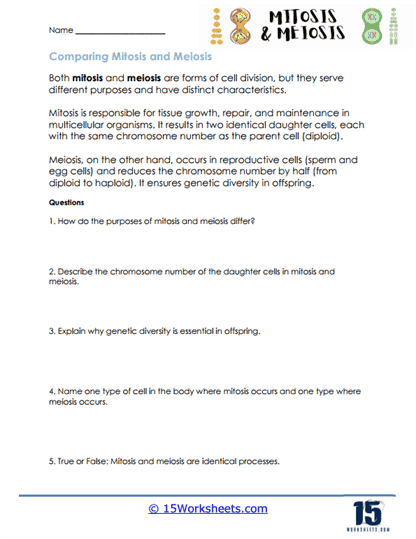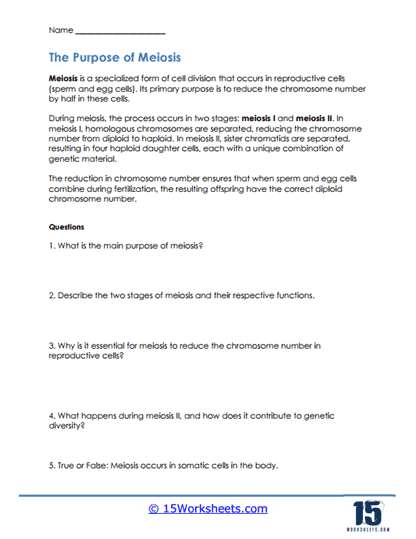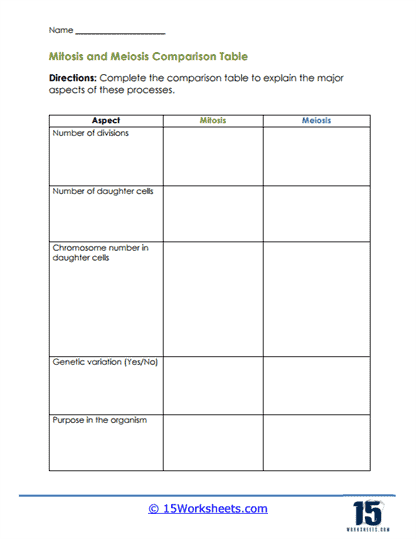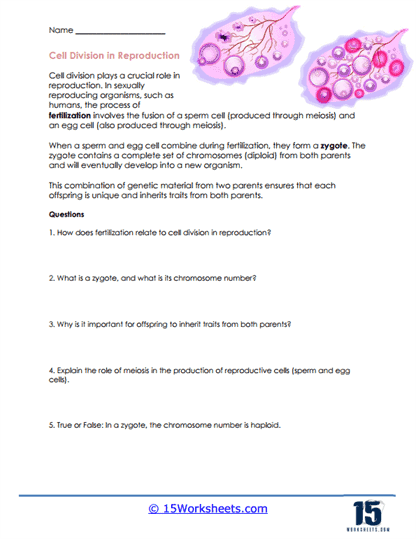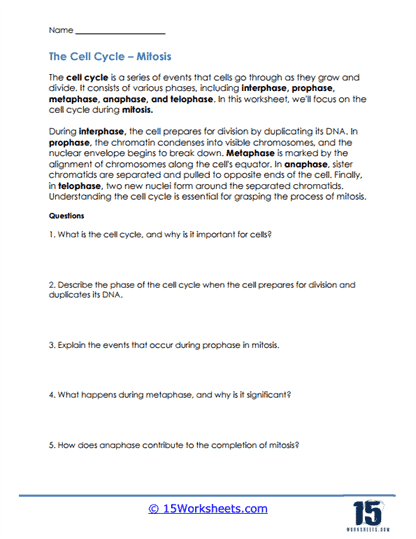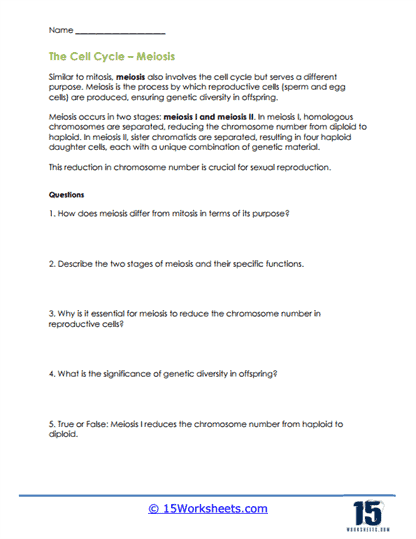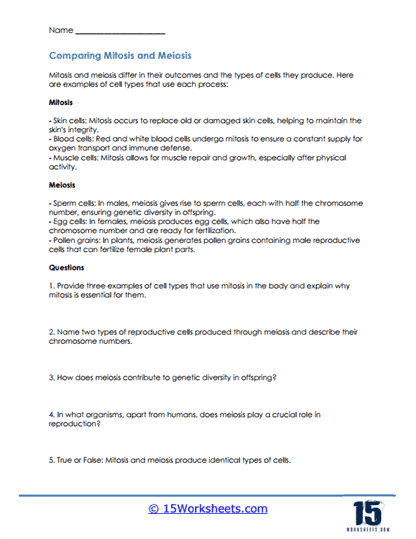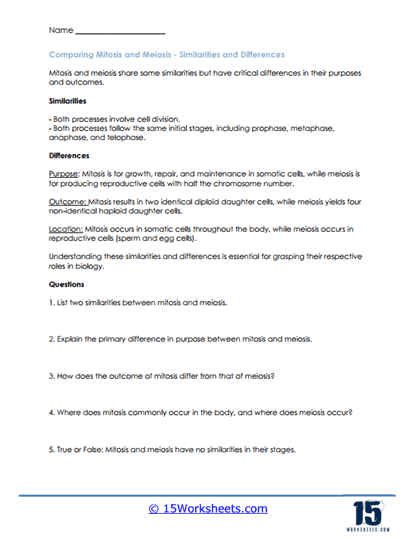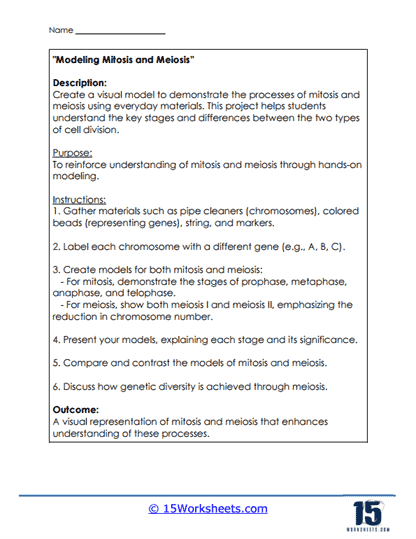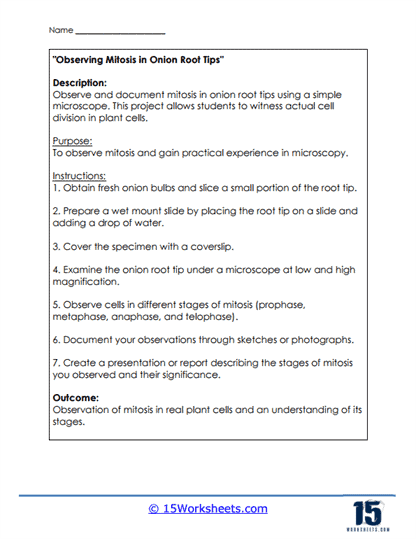Mitosis and Meiosis Worksheets
About These 15 Worksheets
Mitosis and meiosis are fundamental processes in cell biology, governing how cells divide and reproduce. These processes are vital for understanding growth, development, and genetics. These mitosis and meiosis worksheets will help students grasp these essential concepts of how these processes happen and the purpose of them. These worksheets offer a myriad of exercises designed to illuminate the differences, stages, and significance of both mitosis and meiosis.
By engaging with diverse exercise types, students don’t just memorize phases or stages; they internalize the broader significance of cell division in the continuity of life, genetic inheritance, and the intricate ballet of cellular processes. Such worksheets, through their varied exercises, ensure a comprehensive grasp of these pivotal biological concepts.
Types of Exercises on These Worksheets
Multiple Choice Questions (MCQs) – These gauge a student’s basic knowledge and understanding of the concepts.
Example: Which process results in genetic variation? (A) Mitosis (B) Meiosis (C) Both (D) Neither.
True or False – Tests foundational knowledge and dispels misconceptions.
Example: Mitosis results in two genetically identical daughter cells. (True/False)
Fill in the Blanks – These types of questions enforce memory recall and understanding.
Example: _________ produces four non-identical daughter cells, while _________ produces two identical daughter cells.
Matching – Often used to connect stages with their descriptions or phases of cell division with their features.
Example: Match the phase (Prophase, Metaphase, Anaphase, Telophase) with its description.
Diagram Labeling – Visual exercises where students might be given diagrams of cells undergoing mitosis or meiosis. They’ll have to label parts of the cell or identify the stage.
Example: Given a diagram showing chromosomes aligned at the cell’s center, students might label it as “Metaphase.”
Comparative Tables – Students might be asked to fill in or complete tables comparing and contrasting the steps, outcomes, and implications of mitosis and meiosis.
Short Answer Questions – These allow for deeper exploration.
Example: Explain the significance of genetic variation resulting from meiosis.
Flowcharts – Students can be asked to arrange or fill in flowcharts that outline the stages of mitosis or meiosis, ensuring they understand the sequential nature of the processes.
Essay Prompts – More extensive writing exercises that might delve into topics like the significance of cell division in cancer, or the importance of genetic diversity in evolution.
Example: Discuss the role of cell division errors in genetic disorders and their potential implications.
What is Mitosis?
Mitosis is a process where a single cell divides to produce two identical daughter cells. During mitosis, the cell’s nucleus (the control center containing DNA) divides in such a way that each of the two new cells produced has the exact same genetic material as the original cell.
Where Does it Happen?
Mitosis occurs in eukaryotic cells, which include the cells of animals, plants, and fungi. Specifically:
In Animals – It happens in somatic cells, which are essentially all the cells of the body except those involved in reproduction (like sperm and egg cells). This means skin cells, muscle cells, bone cells, and many others undergo mitosis.
In Plants – It occurs in areas called meristems, which are growth regions in plants. These are typically found at the tips of stems and roots.
Why Does it Happen?
There are several reasons why mitosis is essential:
Growth – As organisms grow, more cells are needed to support their increasing size. New cells are made through mitosis.
Repair and Regeneration – When cells are damaged due to wear and tear, injuries, or diseases, mitosis produces new cells to replace the old or damaged ones. For instance, if you get a cut on your skin, new skin cells are made through mitosis to heal the wound.
Replacement – Cells don’t live forever. Over time, many cells age and die, and new ones are needed to take their place. For example, our skin is continuously shedding old cells and replacing them with new ones.
Asexual Reproduction – Some organisms, like certain plants, fungi, and microorganisms, reproduce asexually. This means they create offspring without mating, using mitosis to produce the new organism.
In essence, mitosis is a vital cellular process ensuring that DNA is accurately replicated and passed on, allowing for growth, repair, and even reproduction in some organisms.
What is Meiosis?
Meiosis is a special type of cell division that reduces the number of chromosomes in a cell by half, resulting in four non-identical daughter cells. Unlike mitosis, where one cell division results in two genetically identical cells, meiosis involves two consecutive cell divisions and produces cells with half the original number of chromosomes. This process is essential for sexual reproduction, as it leads to the formation of gametes (sperm and egg cells in animals, and pollen and ovules in plants).
Where Does it Happen?
Meiosis takes place in the reproductive organs of organisms:
In Animals
Males – Meiosis occurs in the testes, producing sperm cells.
Females – It happens in the ovaries, leading to the formation of egg cells.
In Plants
Meiosis happens in the reproductive structures, resulting in the production of pollen (male gametes) and ovules (female gametes).
Why Does it Happen?
The significance of meiosis is multifaceted:
Genetic Variation – Since meiosis results in non-identical daughter cells, it introduces genetic variation within a population. This variation is a driving force of evolution and allows populations to adapt to changing environments.
Halving Chromosome Number – Organisms have a specific number of chromosomes. For instance, humans have 46 chromosomes (23 pairs). For sexual reproduction to work, gametes (sperm and egg) must have half the usual number so that when they fuse during fertilization, the resulting zygote has the correct number. Meiosis ensures gametes have half the number of chromosomes (23 in humans), so the offspring will have the standard amount (46 in humans).
Genetic Shuffling – During meiosis, chromosomes can exchange parts in a process called crossing over. This shuffling and the independent assortment of chromosomes ensure that each gamete is unique, leading to even more genetic variation in offspring.
Fertility and Reproduction – Without meiosis, sexual reproduction wouldn’t be possible. The formation of gametes ensures the continuation of species across generations.
Similarities Between Mitosis and Meiosis
Basic Purpose – Both are processes of cell division, allowing cells to replicate their genetic material and divide.
Stages – Both processes involve stages like prophase, metaphase, anaphase, and telophase, although these stages manifest differently in meiosis and mitosis.
DNA Replication – Before either mitosis or meiosis can begin, DNA replication occurs in the parent cell during the S phase of the cell cycle.
Chromosome Alignment – In both processes, chromosomes align at the cell’s equatorial plane during metaphase, ensuring an organized separation.
Differences Between Mitosis and Meiosis
Number of Divisions
Mitosis involves a single cell division, producing two daughter cells.
Meiosis involves two consecutive cell divisions – meiosis I and meiosis II – resulting in four daughter cells.
Number of Chromosomes
Mitosis produces two daughter cells, each with the same number of chromosomes as the parent cell (diploid).
Meiosis results in four daughter cells, each with half the number of chromosomes as the parent cell (haploid).
Genetic Composition
Mitosis yields daughter cells that are genetically identical to the parent.
Meiosis produces genetically unique daughter cells due to events like crossing over (genetic recombination) and the independent assortment of chromosomes.
Primary Function
Mitosis is involved in growth, repair, and general maintenance of body cells.
Meiosis is essential for sexual reproduction, resulting in the formation of gametes (sperm and eggs in animals; pollen and ovules in plants).
Cell Types
Mitosis occurs in somatic cells (all body cells except reproductive cells).
Meiosis occurs in germ cells and results in the formation of gametes.
Crossing Over
Mitosis does not involve crossing over of genetic material.
Meiosis has a specific phase called prophase I where crossing over or genetic recombination occurs, introducing genetic variation.
Duration
Mitosis is generally a quicker process since it involves only one division.
Meiosis, with its two divisions and more intricate genetic shuffling, is lengthier.

